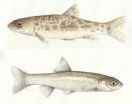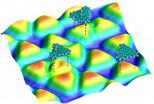(Press-News.org) They show that one of those genes in particular has a long evolutionary history, as evidenced by the fact that it plays a role in pain sensing in flies, mice and humans. At least in mice, the newly described gene is also linked to a condition known in humans as synesthesia, in which one sensory experience triggers the perception of another sense.
"We found lots of new genes and pathways that have never been implicated in pain before," said Josef Penninger of the Institute of Molecular Biotechnology of the Austrian Academy of Sciences.
"From a helicopter view, this shows that there are evolutionarily conserved contributors to pain in flies, mice and humans," added Clifford Woolf of Harvard Medical School, a finding that underscores the importance of pain as a protective mechanism.
Detailed studies in mice show another intriguing feature of the pain gene; it acts in the brain, not in the peripheral nerves, as most known pain genes do.
In what the researchers say is the first genome-wide screen for a complex behavior in flies, thousands of fly genes were silenced using tiny bits of RNA in a method known as RNA interference. Those flies were then tested for their response to noxious heat. In this case, if the flies failed to move away from the heat, they would die.
"We wanted to get as complete a list of genes as possible," Penninger said. "We were almost too successful." The exercise turned up hundreds of genes with a potentially important role in the insects' sense of heat-induced pain.
The research team then focused their attention on one of those genes in particular, known as a2d3 or straightjacket. That gene had no previously known role in pain but was of interest in part because it is related to another gene that is the target of existing analgesic drugs, they explained.
Much like the behavior observed in the flies, mice lacking activity of the gene took longer to jump off of a hot plate. Rare variants of a2d3 were also found in humans with reduced sensitivity to both heat and chronic back pain, they report.
But the researchers were in for another surprise. In the mice, they were able to trace where a2d3 was acting and they saw activity primarily in the brain, not in the nerve endings that are immediately responsible for sensing heat. "We had no idea what it might be doing," Woolf said.
Through functional MRI studies of the brains of sleeping mice as they were exposed to heat, the researchers found that the pain signal in mutants goes to the thalamus of the brain as it should. But that signal is then not sent on properly to higher order pain centers.
Rather, the signal goes instead to other sensory parts of the brain involved in smell, sight and hearing. "Of course, we cannot ask the mouse, but it appears they see, hear and smell the pain signal," Penninger said.
"Here, we found a [pain] gene in the fly that, in the mouse, led us to synesthesia. It was completely unexpected," Woolf said.
The discovery makes the mutant mouse the first model of synesthesia, a condition affecting some four percent of the human population. "There was a famous composer who said he could see his music because each note was a different color," Penninger said. "It's been difficult to study because there had been no model and no genes had been identified."
The researchers also now have hundreds of other pain-related genes that turned up in their initial screen left to explore. In a broad sense, the study shows the power of fly genetics, the researchers say.
"One can really model even complex behaviors like the experience of pain in organisms like the fly and come up with novel pathways that can be translated back to mice and humans," Penninger said. "It works quite well and we learn something entirely new."
But, Woolf added, "the greatest outcome is that we will use this knowledge to identify targets for new analgesics, not just to understand pain." Many of today's pain therapies are relatively ineffective or have severe side effects, he explained. Drug companies are working with perhaps 10 or 20 potential targets for new drugs. "Now, we have hundreds of potential targets, most of them completely novel."
INFORMATION: END
Night-time violence among young Spaniards is becoming ever more common, according to a research study carried out by the European Institute of Studies on Prevention. The study shows that 5.2% of young people carry weapons when they go out at night, 11.6% have been attacked or threatened, and 23% have got into a fight at some time.
"Reports about young people being attacked or injured in fights when they go out at night are becoming increasingly common", Amador Calafat, lead author of the study and a researcher at the European Institute of Studies on Prevention (IREFREA), ...
An international team led by the Forest Technology Centre of Catalonia has carried out the first large-scale study of the threats facing freshwater fish in the Mediterranean basin. Invasive species, along with over-exploitation of water resources, are the most important pressures, and those that expose fish to the greatest risk of extinction.
"The continental fish of the Mediterranean basin are one of the most threatened biological groups in the world", Miguel Clavero, lead author of the study and a researcher from the Landscape Ecology Group of the Forest Technology ...
After four years of conducting intensive calculations in the supercomputer MareNostrum at the Barcelona Supercomputing Center, scientists headed by Modesto Orozco at the Institute for Research in Biomedicine (IRB Barcelona) have presented the world's largest data base on protein motions. Called MoDEL, this new database holds more than 1,700 proteins and is partially accessible through Internet to researchers worldwide. MoDEL has been developed to study the basic biology of proteins and to accelerate and facilitate the design of new pharmaceutical agents.
"Nowadays we ...
Now that the 2010 election is over, here is something to consider for the 2012 race: If you want to fatten your company's profits, contribute to a political campaign.
A study by two College of Business Administration professors at the University of Tennessee, Knoxville, found that when firms engage in corporate political activities, such as lobbying and making campaign contributions, they enjoy about 20 percent higher performance. The study, by Russell Crook and David Woehr, along with Sean Lux of the University of South Florida, entitled "Mixing Business with Politics: ...
Both the bully and the victim's individual characteristics, rather than the wider social environment, explain why bullying occurs, according to Swedish teenagers. The new study, by Dr. Robert Thornberg and Sven Knutsen from Linköping University in Sweden, also shows that 42 percent of teenagers blamed the victim for the bullying. The study is published online in Springer's journal, Child & Youth Care Forum.
In one of the rare studies investigating young people's views on why bullying takes place in school, Thornberg and Knutsen explored how teenagers explain bullying ...
Electronic components are getting smaller and smaller, with microelectronic components gradually being replaced by nanoelectronic ones. On nanoscale dimensions, silicon, which is at the present stage the most commonly used material in semiconductor technology, reaches however a limit, preventing further miniaturization and technological progress. New electronic materials are therefore in great demand. Due to its outstanding electronic properties, graphene, a two-dimensional carbon network, is considered as a possible replacement. However, several obstacles must be overcome ...
Fear arises in the almond-shaped brain structure known as the amygdala. It is the amygdala which processes the strange noise, shadowy figure or scary face and not only triggers palpitations or nausea but can also cause us to flee or freeze. That much has long been known about the function of this part of the brain. What remains largely unclear, however, is precisely how fear develops, and which of the countless neurons in the amygdaloid region are involved in this process. But finding answers to these questions is vital for those who wish to improve the quality of life ...
Spanish and American researchers have conducted a mineralogical and chemical analysis to ascertain the origin of "terra rossa" soil in the Mediterranean. The results of the study reveal that mineral dust from the African regions of the Sahara and Sahel, which emit between 600 and 700 tonnes of dust a year, brought about the reddish soil in Mediterranean regions such as Mallorca and Sardinia between 12,000 and 25,000 years ago.
"The first hint of the relationship between African dust and certain soils in the region of the Mediterranean is their reddish or reddish-brown ...
MAYWOOD, Ill. -- Alcohol does much more harm to the body than just damaging the liver. Drinking also can weaken the immune system, slow healing, impair bone formation, increase the risk of HIV transmission and hinder recovery from burns, trauma, bleeding and surgery.
Researchers released the latest findings on such negative effects of alcohol during a meeting Nov. 19 of the Alcohol and Immunology Research Interest Group, held at Loyola University Medical Center.
At Loyola, about 50 faculty members, technicians, post-doctoral fellows and students are conducting alcohol ...
DURHAM, N.C. -- Leaks from carbon dioxide injected deep underground to help fight climate change could bubble up into drinking water aquifers near the surface, driving up levels of contaminants in the water tenfold or more in some places, according to a study by Duke University scientists.
Based on a year-long analysis of core samples from four drinking water aquifers, "We found the potential for contamination is real, but there are ways to avoid or reduce the risk," says Robert B. Jackson, Nicholas Professor of Global Environmental Change and professor of biology at ...



